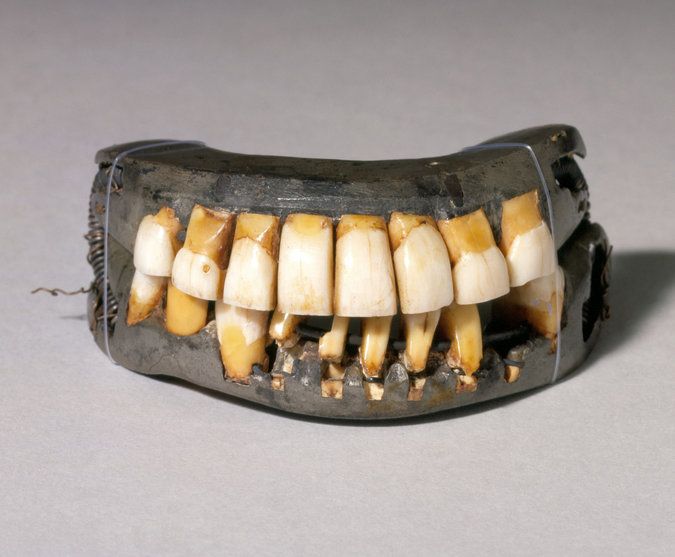A Brief History of Dentures

George Washington’s Dentures
https://www.pinterest.com.au/pin/16888567328431544/
As a top dental supplies Melbourne company providing everything dentists, dental surgeons, dental hygienists, and orthodontists need to operate their clinics, we distribute a vast array of the dental and clinical supplies required for fitting, making, and maintaining dentures.
Did you know that dentures and replacement teeth have been used in one form or another for more than 3500 years?
The story of the evolution of dentistry, including the history of dentures, is quite fascinating and shows us not only how far this type of dentistry has come, but at the same time, how little has really changed.
The First Dentures
False teeth have been found in archaeological sites in Mexico and Egypt. Ancient Indigenous Mexicans replaced their missing teeth with wolf teeth, inserting the tooth directly into the socket from which the human tooth was missing. Mayans used pieces of bone, seashells, and stones; these were carved into shape and used to replace missing teeth. It’s quite remarkable to note how well these methods worked, with the replacement tooth or other material even fusing to the jaw of the “patient” for a permanent result.
The ancient Egyptians of 1500BC collected human teeth and joined them together with gold wire. These were a cosmetic but not particularly functional solution for missing teeth.
The earliest incarnation of what we’d recognize as modern dentures dates to the Etruscan civilization of around 700BC. Located in what is now Northern Italy, these people made replacements for missing human teeth from the teeth of deceased humans or animals, tied together with wires. These early dentures did not last very long and were, as for the Egyptians, most likely used for cosmetic purposes rather than for eating.
The Japanese were the first people to make wooden dentures, and these looked remarkably like what we know as dentures today, relying on suction on the gums and palate to remain in place. The oldest surviving example of wooden dentures dates to the early 1500s and was found in Japan, having been made for a priestess.
The 1700s
Modern dentistry dates to the early 1700s and French Physician Pierre Fauchard.
Why did so many people suddenly need false teeth in the 1700s? Sugar had become widely available throughout Europe over the last 100-200 years and was a dietary staple. The Royal Courts of Tudor England were renowned for their sweet treats, and Queen Elizabeth I was described as having blackened and missing teeth later in her life in the 1500s.
Dentistry was yet to become the science it is today, and few people who lived to the ripe old age of 50 years had all (if any) of their natural teeth.
By the early 1700s, people had discovered the value of using elephant, hippopotamus, and walrus ivory to make false teeth. These teeth did not look natural and they decayed easily. Early dentures were painful to wear, difficult to fit, and it was trial-and-error for a long time to make them into what we are familiar with today.
George Washington was renowned for having wooden dentures. This is a myth! His dentures were crafted to the highest standards of the time. His first partial denture was ivory teeth wired to his natural teeth. Later he had a full denture (excepting one remaining natural tooth) from a carved plate of hippopotamus ivory. Onto this, human, donkey, and horse teeth were mounted.
In the 1770s, French dentists sought a better, stronger, more durable alternative, and porcelain was used for the first time to create dentures by physician Alexis Duchateau. This was very expensive. Each tooth was painted individually to resemble natural teeth. Despite the best intentions, porcelain teeth proved to be substandard, shrinking and becoming brittle when fired in the kiln.
The 1800s
It became very commonplace to use human teeth to make dentures, as they were so durable and considered to be superior. They were often called “Waterloo Teeth”, as teeth were harvested from 50,000 dead soldiers after the Battle of Waterloo in 1815. These men were young and their teeth were of high quality. (The American Civil War provided a similar source of human teeth in the 1860s). Human teeth were also taken from executed criminals, stolen from graves, and some poorer people even sold their teeth.
Human teeth were mounted onto an ivory plate that fitted over the gums. Using human teeth was very expensive and only the wealthiest could afford this option.
In 1820, an English goldsmith and silversmith named Claudius Ash tried mounting porcelain teeth onto gold plates using gold swivels and springs. The results were functionally superior to previous models, but they were very expensive and difficult to clean.
From 1850, porcelain teeth had been improved upon and were mounted onto vulcanite for the first time. This was a hard but somewhat flexible rubber material and was more comfortable a base than ivory or gold. It was also more affordable and enabled the middle classes to have access to false teeth. These dentures were mass-produced by Ash & Sons for many decades.
The 1900s
Advances in the 1900s revolutionized dentures. The invention and development of acrylic resins, as well as technological advances in fit, suction, and functionality, and higher comfort levels, made dentures a much better option for dental health, especially before the advent of fluoride toothpaste and fluoridation of the drinking water supply.
The acrylic resin dentures of the early 20th century were incredibly well made and durable. (This writer’s grandmother wore the same set from 1938-2016!)
Dentures Today
We are very fortunate to live in an age with the most advanced techniques, materials, technology, and dental supplies. Tooth replacement using titanium dental implants is becoming more popular, however, dentures are still very widely used and represent a more affordable option for a lot of patients. It is an aspect of dentistry that is here to stay.